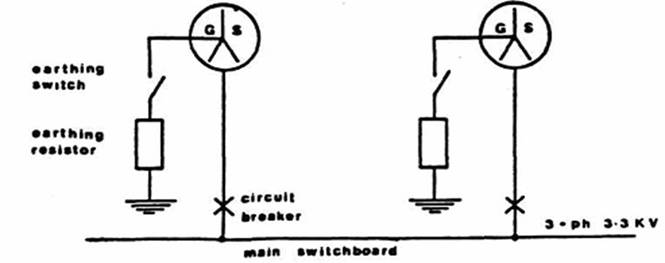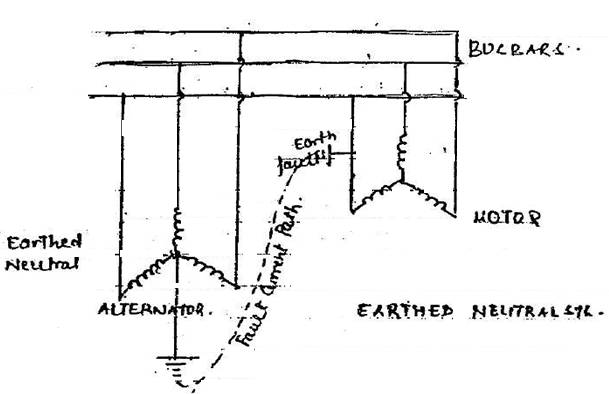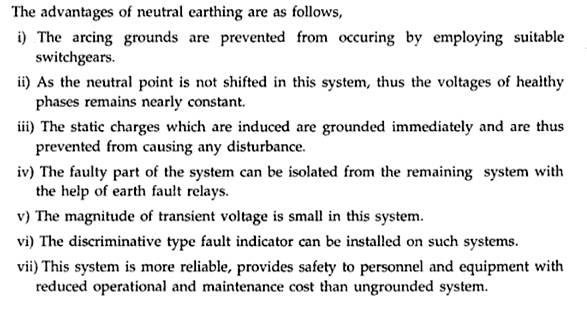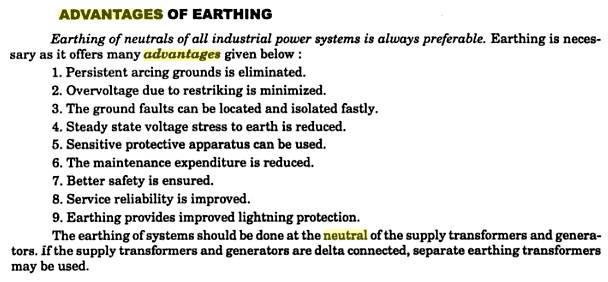Question
With reference to a three
phase shipboard electrical distribution system:
(a) Enumerate the advantages of an insulated
neutral system,
(b) Enumerate the disadvantages of an insulated
neutral system;
(c) Describe how the earthed neutral system is
earthed,
(d) Compare the use of an insulated neutral
system as opposed to the use of an earthed neutral system with regard to the
risk of electric shock from either system.
An insulated system is one
that is electrically insulated from earth.
Advantages
If an earth fault occurs on the insulated pole of an ‘EARTHED
DISTRIBUTION SYSTEM’ it would be equivalent to a ‘short circuit’ fault across
the load via the ship’s hull.
The resulting large earth fault current would immediately
‘blow’ the fuse in the line conductor. The faulted electrical equipment would
be immediately isolated from the supply and so rendered SAFE, but the loss of
equipment could create a hazardous situation, especially if the equipment was
classed ESSENTIAL, e.g. loss of steering gear. The large fault current could
also cause arcing damage at the fault location.
An earth fault ‘A’ occurring on one line of an ‘INSULATED
DISTRIBUTOIN SYSTEM’ will not cause any protective gear to operate and the
system would continue to function normally. This is the important – equipment
still operates. The single earth fault does not provide a complete circuit so
no earth fault current will exist.

If an earth fault ‘B’ developed on another line, the two
earth faults together would be equivalent to a short-circuit fault (via the
ship’s hull) and the resulting large current would operate protection devices
and cause disconnection of perhaps essential services creating a risk to the
safety of the ship.
An insulated distribution system requires TWO earth faults on
TWO different lines to cause an earth fault current.
An earthed distribution system requires only ONE earth fault
on the LINE conductor to create an earth fault current.
An insulated system is, therefore, more effective than an
earthed system in maintaining continuity of supply to equipment.
Hence its adoption for most marine
electrical systems.
Disadvantages
Although fault current is very
small / negligible over voltage are high
Voltage to earth is 1.73Vph
[√3Vph]
Tracing the earth fault is
more difficult although the selective tripping may trace the faulty circuit,
the actual position of the fault may still be difficult to locate
Earthed neutral system. Neutral point connected to earth. Usually for HV system e.g. for 3.3Kv system. Main priority
is immediate isolation of earth faulted equipment
Earth fault current is very high but over voltage due to
earth fault are lower. The earthed system is chosen to limit overvoltage and give
automatic earth fault location and disconnect
High voltage systems (3.3 kV and above) on board ship are
normally ‘earthed’. Such systems are normally earthed via resistor connecting
the generator neutrals to earth as shown below.

The ohmic value of each earthing resistor is usually chosen so as to limit the
maximum earth fault current to not more than the generator full load current.
Such a Neutral Earthing Resistor (NER) is often
assembled with metallic plates in air but liquid (brine) resistors have also
been used. The use of such an earthed system means that a single earth fault
will cause that circuit to be disconnected by its protection device. Certain
essential loads (e.g. steering gear) can be supplied via a transformer with its
secondary unearthed to maintain security of supply in the event of a
single-earth fault. Regulations insist that tankers have only insulated
distribution systems. This is intended to reduce danger from earth fault
currents circulating in the hull in hazardous zones which may cause an
explosion of the flammable cargo.
An exception allowed by regulating bodies occurs where a
tanker has a 3.3 kV earthed system. Such a system is permitted providing that
the earthed system does not extend forward of the engine room bulkhead and into
the hazardous zone area. Electrical supplied forward of the engine room
bulkhead are usually 3-phase 440V insulated and obtained from a 3-phse 3.3
kV/440V transformer.
In a insulated neutral system, very
small current will flow through an earth fault on one phase, because there is
no easy path for it to come back to the electrical system
In an earthed neutral system, the result of not isolating the
electrical system from the hull is that current flow from an earth fault on any
phase has a path through the hull steel and earthed neutral back to the system.
The availability of path encourages higher fault current
flow. Equipment with an earth fault, where the system is earthed must be
disconnected immediately because high fault current may cause shock and fire.
To protect against danger of electric shock and fire that may
result from earth fault the metal enclosure and other non current metal parts
of electrical equipment must be earthed. The earthing
conductor connects the metal enclosure to earth the ships hull to prevent it
from attaining a dangerous voltage with respect to earth. Such earth bonding of
equipment ensure that it always remains at zero volts

Notes




